Plagiaulacida is a group of extinct multituberculate mammals. Multituberculates were among the most common mammals of the Mesozoic, "the age of the dinosaurs". Plagiaulacids, an informal suborder, are the most basal of this order, and ranged from the Middle Jurassic Period to the Lower Cretaceous Period of the northern hemisphere.

Pelorosaurus is a genus of titanosauriform sauropod dinosaur. Remains referred to Pelorosaurus date from the Early Cretaceous period, about 140-125 million years ago, and have been found in England and Portugal. Thomas Holtz estimated its length at 24 meters.
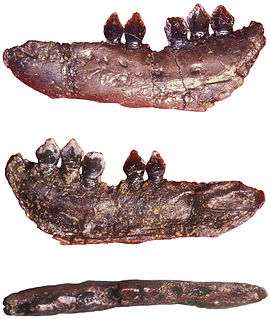
Echinodon is a genus of heterodontosaurid dinosaur that lived during the earliest Cretaceous of southern England in the Berriasian epoch. The first specimens were jaw bones named Echinodon becklesii by Sir Richard Owen in 1861, and since their original description only additional teeth have been discovered. The specific name honours collector Samuel Beckles who discovered the material of Echinodon and many other taxa from across England, while the genus name translates as "prickly tooth" in reference to the dental anatomy of the taxon.

Goniopholis is an extinct genus of goniopholidid crocodyliform that lived in Europe and Africa during the Late Jurassic and Early Cretaceous. Being semi-aquatic it is very similar to modern crocodiles. It ranged from 2–4 metres in length, and would have had a very similar lifestyle to the American alligator or Nile crocodile.
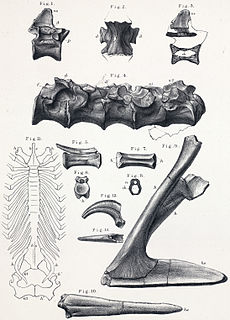
Aristosuchus is a genus of small coelurosaurian dinosaur whose name was derived from the Greek ἄριστος and σουχος. It shared many characteristics with birds.

Valdoraptor is a genus of theropod dinosaur from the Early Cretaceous. Its fossils were found in England. It is known only from bones of the feet. The holotype, BMNH R2559, was found near Cuckfield in layers of the Tunbridge Wells Sand Formation dating from the late Valanginian. The specimen is damaged lacking parts of the upper and lower ends. It has a conserved length of 215 millimetres (8.5 in) and an estimated length of 240 millimetres (9.4 in). This genus is paleontologically significant for being the first ornithomimosaur specimen known from England and represents the earliest record of ornithomimosaurs.

Ornithopsis was a medium-sized Early Cretaceous sauropod dinosaur, from England. The type species, which is the only species seen as valid today, is O. hulkei.

Nuthetes is the name given to a dubious, possibly dromaeosaurid, genus of theropod dinosaur, known only from fossil teeth and jaw fragments found in rocks of the middle Berriasian age in the Cherty Freshwater Member of the Lulworth Formation in England. As a dromaeosaurid, Nuthetes would have been a small predator.
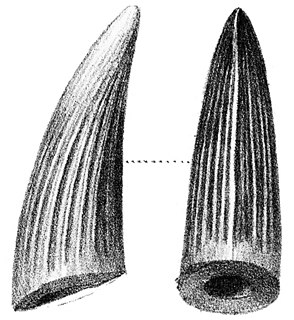
Suchosaurus is a spinosaurid dinosaur from Cretaceous England and Portugal, originally believed to be a genus of crocodile. The type material, consisting of teeth, was used by British palaeontologist Richard Owen to name the species S. cultridens in 1841. Later in 1897, French palaeontologist Henri-Émile Sauvage named a second species, S. girardi, based on two fragments from the mandible and one tooth discovered in Portugal. Suchosaurus is possibly a senior synonym of the contemporary spinosaurid Baryonyx, but is usually considered a dubious name due to the paucity of its remains. In the Wadhurst Clay Formation of what is now southern England, Suchosaurus lived alongside other dinosaurs, as well as plesiosaurs, mammals, and crocodyliforms.

Polyptychodon is a genus of pliosaurid found in Middle-Late Cretaceous marine deposits in southern England and Patagonia. It has been considered a nomen dubium in a 2016 review.
Tinodon is an extinct genus of mammal alive 155-140.2 million years ago (Oxfordian-Berriasian) which has been found in the Morrison Formation, the Alcobaça Formation (Portugal) and the Lulworth Formation (England). It is of uncertain affinities, being most recently recovered as closer to therians than eutriconodonts but less so than allotherians. Two species are known: T. bellus and T. micron.
Paramacellodus is an extinct genus of scincomorph lizards from the Early Cretaceous of England the Late Jurassic of Portugal and the western United States. The type species, Paramacellodus oweni, was named in 1967 from the Purbeck Formation in Dorset, England. Additional material referable to a species of Paramacellodus, possibly P. oweni, has been described from the Morrison Formation, specifically in Como Bluff, Wyoming, and Dinosaur National Monument, Utah. Paramacellodus belongs to an extinct family of scincomorphs called Paramacellodidae, which spanned most of Laurasia during the Late Jurassic and Early Cretaceous and represented one of the earliest evolutionary radiations of lizards.

Dorsetochelys is an extinct genus of turtle from the Early Cretaceous of southern England and northwestern Germany.
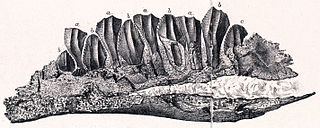
Owenodon is a genus of iguanodontian dinosaur known from a partial lower jaw discovered in Early Cretaceous-age rocks of Durlston Bay, Dorset, United Kingdom and also possibly known from fragmentary remains found in the Bauxite of Cornet Formation in Romania. The specimen, NHM R2998, comes from the Purbeck Limestone, dating to the middle Berriasian stage. It was first described by Richard Owen, who in 1874 assigned it to Iguanodon as the type specimen of the new species I. hoggii, the specific name honouring naturalist A.J. Hogg who had originally collected the fossil in 1860. The bone was damaged during initial preparation but was freed from the surrounding rock matrix by an acid bath between 1975 and 1977. David Norman and Paul Barrett subsequently transferred the species to Camptosaurus in 2002, but this was challenged, and in 2009 Peter Galton assigned the species to the new genus Owenodon, meaning "Owen's tooth", named after Sir Richard Owen. Galton interpreted the genus as an iguanodontoid more derived than Camptosaurus but less derived than Lurdusaurus.
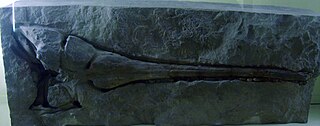
Pholidosaurus is an extinct genus of neosuchian crocodylomorph. It is the type genus of the family Pholidosauridae. Fossils have been found in northwestern Germany. The genus is known to have existed during the Berriasian-Albian stages of the Early Cretaceous. Fossil material found from the Annero and Jydegård Formations in Skåne, Sweden and on the island of Bornholm, Denmark, have been referred to as a mesoeucrocodylian, and possibly represent the genus Pholidosaurus.
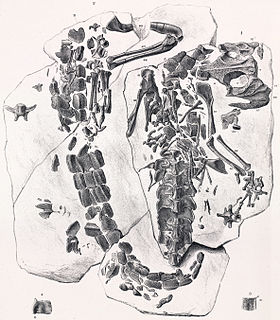
Theriosuchus is an extinct genus of atoposaurid mesoeucrocodylian from Late Jurassic to Early Cretaceous of Europe, Southeast Asia (Thailand) and western North America (Wyoming), with fragmentary records from Middle Jurassic and Early Cretaceous sites in China, Morocco, and Scotland.

Pleurosternon is an extinct genus of cryptodire turtle from the late Jurassic period to the early Cretaceous period. Its type species, P. bullocki was described by the paleontologist Richard Owen in 1853. Since then, and throughout the late 19th century, many fossil turtles were incorrectly assigned to this genus.

Triconodon is a genus of extinct mammal from the Early Cretaceous of England and France with two known species: T. mordax and T. averianovi. First described in 1859 by Richard Owen, it is the type genus for the order Triconodonta, a group of mammals characterised by their three-cusped (triconodont) molar teeth. Since then, this "simplistic" type of dentition has been understood to be either ancestral for mammals or else to have evolved multiple times, rendering "triconodonts" a paraphyletic or polyphyletic assemblage respectively, but several lineages of "triconodont" mammals do form a natural, monophyletic group, known as Eutriconodonta, of which Triconodon is indeed part of.
Hylaeochelys is an extinct genus of plesiochelyid turtle that lived during the Late Jurassic-Early Cretaceous in Portugal, Spain and southern England. The type species was originally named by Richard Owen as Pleurosternon latiscutatum in 1853, before being moved to the new genus Hylaeochelys by Richard Lydekker in 1889. Other species included in the genus are H. belli, H. kappa and H. lata, originally named under different genera by Gideon Mantell and Owen, respectively. All species are represented by carapaces, primarily from the Lulworth Formation of the Purbeck Limestone Group that was deposited during the Berriasian.
Kouriogenys is a genus of extinct mammal from the Early Cretaceous of southern England. The type and only species was originally described as Spalacotherium minus by Richard Owen in 1871 for a dentary with teeth from the Berriasian Lulworth Formation, although it was given its own genus in 2012 by Brian Davis. The genus name is taken from the Ancient Greek "youthful" and "jaw" in reference to the replacement method of the premolars. Kouriogenys is closely related to coexisting genera Peramus and Peramuroides, and along with other genera these make up the family Peramuridae, a group of extinct zatherians.
















